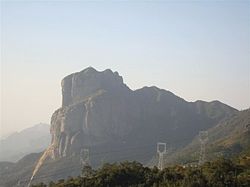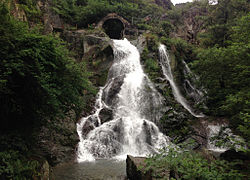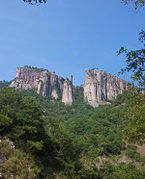Middle Yandang Mountains
History
The history of Yandang Mountains is quite long. The time when human first went here and built their house could be traced back to Southern and Northern Dynasties. However, when it comes to Middle Yandang Mountain, it was Song dynasty when the chin-shih Li Shao-he (Chinese: 李少和) first came here and built a Taoism Temple. Then more and more people came here because of the fame of Li Shao-he and religious ethos.
In modern China, to facilitate the growth of local economy, both local government and indigenous people want to build a scenic spot base on Middle Yandang Mountains. However, the condition of government finance was not good, which means if people want to construct the scenic spot, they need pay the fare of project. Finally, villagers raised money by themselves and built the scenic spot.
The entrance tickets of scenery spot are free for local people. Many local schools organize an annual spring excursion here.
Poetry
千里带长堤,
万里泻长汀。
——谢灵运/Xie Ling-yun
In ancient China, many poets habitually wrote or sang poetry upon encountering a beautiful landscape. They depicts the landscape and express their aspirations and feelings by it. In Middle Yandang Mountains, many poets left their opus, like Xie Lingyun and Wang Shi-peng.
Xie Ling-yun (Chinese: 谢灵运)

In 422 A.C, Xie was sent to Yongjia County as prefecture chief. One day, he came to the root of Middle Yandang Mountains and inspected the farms. At that time, he was attracted by the landscape and wrote, "The far embankment lies thousands of miles, the long spit of land like river flows millions of miles." (Chinese: 千里带长堤,万里泻长汀。)Because of the fame of Xie, Middle Yandang Mountains became more and more well-known.
Wang Shi-peng (Chinese: 王十朋)
Wang was one of the Zhuangyuan in Southern Song dynasty(1127–1279), whose homeland was Yueqing, a city now lies at the root of Middle Yandang Mountains. He wrote, "The lakes and mountains like green lies here, and the two streams flows like the sound of Chinese Zither." (Chinese: 十里湖山翠黛横,两溪寒玉斗琮琤)
Others
Except Xie and Wang, there were still some poets writing poems for specific mountains or lakes. Poet lived in Tang dynasty(618–907) called Zhang You-xin (Chinese: 张又新) sang a poetry for Yu-zhen Peak that "The Lake in front of the Yu-zhen Peak with spring is here, there is clean dust on the road aside." (Chinese: 白石岩前湖水春,湖边旧径有清尘) Another poet in Qing dynasty called Lin Qi-heng (Chinese: 林启亨) wrote, "The peak rises steeply from the ground just like a post, the length of it seems to break through the sky" (Chinese: 拔地一峰真似柱,巉岩百丈欲撑天), which depicted the appearance of Bai-zhang Peak. At the East Waterside, there is a rock similar to a woman who is waiting for her husband called Mrs. Rock. A poet in Ming dynasty(1368–1644) named Gao You-ji (Chinese: 高友玑) wrote, "Standing alone and gazing into the border of sky, there are only rocks near myself." (Chinese: 亭亭独立望天津,四畔无家石相邻)
Speciality crop

Indigo, a plant used to dye clothing, which could make the cloth blue. It has been regarded as an ingredient of dye for a long time. In Encourage Learning, an article of Xunzi, indigo was mentioned as a metaphor that students will be better than teachers. (Chinese: 青出于蓝而胜于蓝) In 1940–1956, the output of indigo continued to increase. However, after that time, with the importation of foreign dye, the production of indigo has been decreased. Nowadays, there are only a few people planting indigo.
Indigo also can be used as an ingredient of medicine, especially its root. In 2003, when SARS was spreading widely in China, the root of indigo has been made as a medicine called Isatis (Chinese: 板蓝根)
Tourism
| Scenery Spots | |||||
|---|---|---|---|---|---|

| |||||
| Yu-zhen Peak 玉甄峰 | |||||
| No. | Name | Kanji | |||
| 1 | Yu-zhen Peak | 玉甄景区 | |||
| 2 | Three Lakes | 三湖景区 | |||
| 3 | West Waterside | 西漈景区 | |||
| 4 | East Waterside | 东漈景区 | |||
| 5 | Phoenix Mountain | 凤凰山景区 | |||
| 6 | Yang-ba Hole | 杨八洞景区 | |||
| 7 | Liu-Gong Valley | 刘公谷景区 | |||
There are seven scenery spots in Middle Yandang Mountains, including Yu-zhen Peak, Three Lakes, West Waterside, East Waterside, Phoenix Mountain, Yang-ba Hole and Liu-Gong Valley.
Yu-zhen Peak
Yu-zhen Peak is the main peak of the scenery spots and regarded as the totem of Middle Yandang Mountains. It seems that Yu-zhen Peak is quite high although the absolute elevation is just approximately 568 m. At the top of the mountain, there is a Taoism Temple there, which is built by chin-shih Li Shao-he. The main part of the mountain is rock and the Taoism Temple lies here, local people also call it Taoist Priest Rock. Thanks to wide rock walls, artists and litterateurs created their work here so that there are many lithographs.
Except the main temple, there is also a cave called Yu-hong Cave, which lies the middle of the peak, including a group of Taoism constructions. According to the book Treasure Trove of Heaven in Song dynasty, it was regarded as the Twenty-first cave of the country. In Ming dynasty, a Buddhist monk came here and modified the Taoism Temple to a Buddhist Temple, which called Yu Ping Zen Temple. Therefore, both Taoism and Buddhism had been here. However, in March, 2014, the temples caught fire and constructions built in Qing dynasty was lost.
Three Lakes
Three Lakes consist of Bai-shi Lake, Zhong-qian Lake and Long-shan Lake, which are all man-made lakes and built in 1950s-1960s. Bai-shi Lake was built in 1958, which was mainly used to prevent flooding and irrigation, but also generate electricity and supply water. The reservoir has a storage capacity of about 11.97 million cubic meters. After the completion of Bai-shi Lake, Zhong-Dian Lake began to be built and its storage capacity is 23.5 million cubic meters. Lakes here provide visitors with services like fishing, sightseeing, as well as going boating. Therefore, it becomes a part of Middle yandang Mountains Scenery Spots. It is said that the Chinese television drama Nirvana in Fire (Chinese: 琅琊榜) found views here at the first episode.
West Waterside
West Waterside is a valley with an approximately 200 meters' river and the bottom of river is flat and yellow, which is similar to the appearance of Chinese dragon. Thus, it is called Dragon Street (Chinese: 龙街). In this area, Bai-zhang Peak (Chinese: 百丈峰), Jade Screen Peak (Chinese: 玉屏峰), Rock Door (Chinese: 石门) and Rock Door Waterfall (Chinese: 石门瀑) become the main elements of the scenery spot. Bai-zhang Peak is a peak like a post which highs about 200 meters, and next to it is Jade Screen Peak (Chinese: 玉屏峰), which is similar to the Chinese folding screen.

East Waterside
East Waterside is also a valley which lasts 3.5 kilometers long. According to County Annals of Yue Qing, it is said that at the southeast of Yu-zhen Peak, there is a place called East Waterside, including a river called East Dragon Street (Chinese: 东龙街), six ponds where Mei-yu Pond (Chinese: 梅雨潭), Hong-jing Pond (Chinese: 渹井潭) and Zhong Pond (Chinese: 钟潭) are the most famous, three peaks called Stele Peak (Chinese: 石碑峰), Rosy Clouds Peak (Chinese: 彩霞峰) and Mrs Rock Peak (Chinese: 石夫人峰), and a waterfall called Mei-yu Waterfall (Chinese: 梅雨瀑). A Chinese writer called Zhu Ziqing (Chinese: 朱自清) has traveled here and left an article named Green about Mei-yu Pond.
Phoenix Mountain

Phoenix Mountain is a mountain with approximately 500 meters, which lies on the periphery of the Bai-shi town and faces to Yu-zhen Peak. People regard it as the reflection of Yu-zhen Peak. There are tens of peaks here, including Hawk-mouth Peak (Chinese: 鹰嘴岩), Chuan-bi Peak (Chinese: 穿鼻岩), Ban-zhang (Chinese: 板障岩) and so on.
Yang-ba Hole
Yang-ba Hole (Chinese: 杨八洞) is a place built with Taoist style and was seen as the Nineteenth Cave of the country according to Taoism Book named Yun Ji Qi Qian (Chinese: 云笈七签). There are eight caves here, including Bao-guang (Chinese: 宝光), Guan-yin (Chinese: 观音), Tou-tian (Chinese: 透天), Tou-hai (Chinese: 透海), Long-gun (Chinese: 龙滚), Ba-xian (Chinese: 八仙), Hun-yuan (Chinese: 混元), Yu-chan (Chinese: 玉蟾). Guan-yin is a symbol of Buddhism while others are all important images of Taoist culture.
Liu-gong Valley
Liu-gong Valley also lies on the periphery of Middle Yandang Mountains. In 1132, the county magistrate of Yue Qing County organized workers to dig a canal and build the dykes and dams, which solved the flood and protect the benefits of citizens. To memorize him, people call the valley Liu-gong Valley. It is said that in the Jin dynasty (266–420), a literary celebrity named Ruan-fang (Chinese: 阮放) has lived in seclusion and Wang Xizhi(Chinese: 王羲之) came here to visited him. Therefore, many poets and calligraphers visited here and left their work.
Gallery
Here are more photos about Middle Yandang Mountains.
-
Three Lakes 三湖
-
Three Lakes 三湖
-
East Waterside 东漈
-
East Waterside 东漈
-
Phoenix Temple 凤凰山道观
-
Phoenix Mountain 凤凰山
-
Mei-yu Pong 梅雨潭
-
West Waterside 西漈
-
West Waterside 西漈
-
Yu-zhen Peak 玉甄峰
-
Stream in Middle Yandang Mountains 山间小溪
-
Bai-zhang Peak 百丈峰
-
Jade Screen Peak 玉屏峰
-
Xuan Guan 悬关
References
- ^ Yandang. 闽北日报. Retrieved on 2015-11-11
- ^ The Best Ten Summer Resort. Archived 2014-09-17 at the Wayback Machine zj.xinhuanet.com. Retrieved on 2015-11-11.
- ^ The first time of excavation. Archived 2016-03-04 at the Wayback Machine 温州市雁荡山风景旅游管理委员会. Retrieved on 2015-11-11
- ^ The historic fact of Li Shao-he. Archived 2016-03-04 at the Wayback Machine 乐清旅游资讯网. Retrieved on 2015-12-11
- ^ The construction scenic spot. Archived 2016-03-04 at the Wayback Machine 乐清旅游资讯网. Retrieved on 2015-11-11
- ^ 千里带长堤... 温州旅游网. Retrieve at 2015-11-25
- ^ 中雁荡山 中国旅游报·数字报. Retrieved in 2015-12-05
- ^ 荀子集解, [清]王先谦 著, 中华书局, 2013, 9787101090024
- ^ 中雁特产靛青 温州外宣网. Retrieved in 2015-12-11.
- ^ 玉虹洞道观失火 温都新闻 Retrieved in 2015-12-04
- ^ 白石湖 Archived 2016-05-01 at the Wayback Machine 温州市水利局 Retrieved in 2015-12-04.
- ^ 钟前湖 Archived 2016-03-05 at the Wayback Machine 乐清市水利局 Retrieved in 2015-12-04.
- ^ 《琅琊榜》取景浙江 浙江在线·旅游 Retrieved in 2015-12-04
- ^ 中雁荡:巉岩百丈 西漈春深 钱江晚报. Retrieved on 2015-12-05
- ^ County Annals of Yue Qing, 道光乐清县志, [清]鲍作雨, 张振夔|主编:许宗斌|校注:陈纬, 线装书局, 2009, 9787801068798
- ^ 朱自清散文, 朱自清, 浙江文艺出版社, 2014, 9787533935993
- ^ 凤凰山景区. 乐清旅游资讯网. Retrieved on 2015-12-10
- ^ 杨八洞. 乐清旅游资讯网. Retrieved on 2015-12-10
- ^ 刘公谷和刘公塘. 中国乐清网. Retrieved on 2015-12-10.
External links
- Wang Shi-peng More details about Wang Shi-peng.













